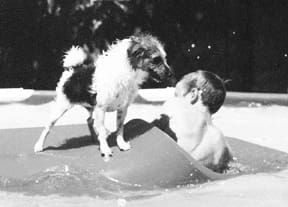Cocoa is a Lab-mix who goes crazy when we are in our pool. She runs around the pool barking and will not settle down. I have tried to calm her verbally, petted her, etc. But as soon as we move in the water, she goes crazy. She will run until she is exhausted. I thought about putting her in the pool with us, but I’m worried she will be too crazy.
Liam Smith, via e-mail
WDJ’s Training Editor, Pat Miller, of Hagerstown, Maryland, responds:
There are several solutions and approaches for Cocoa’s canine behavior. The first, and probably the easiest, is simple management. If you don’t want her to run around the pool endlessly while you and the family are enjoying a dip, give her a luscious stuffed Kong and put her somewhere else – in the house where she can’t see you through a window, in her crate, in the garage – anywhere she’ll relax and be calm until you return to dry land.
The major benefit of this solution is that it’s quick and simple.

The downside is you have to shut Cocoa away from the family fun, and she may object to being isolated from the pool party.
You could, as you suggest, teach her to swim in the pool with you. If you choose this training option, you’ll also want to show her where the steps are and teach her how to get out unassisted, in case she should end up in the pool when no one is there to rescue her.
The benefit of this solution is that Cocoa can be a part of the family fun. However, she may be overenthusiastic and happily maul and submerge family members in her excitement. Or, she may help herself to pool parties she’s not invited to.
Another training option might be to teach her a very solid down-stay or some other behavior that’s incompatible with running around the pool. It would take a high degree of training to achieve reliable compliance in the face of the constant stimulus of your family in the water – and would probably diminish your own enjoyment of the pool as someone would have to constantly monitor Cocoa and reinforce the desired behavior, at least at first.
Behavioral solution
Finally, you could implement a program of counter-conditioning and desensitization (CC&D). When you say, “The dog goes crazy” a behaviorist would say that the dog is having a strong conditioned emotional response (CER) to some stimulus, which suggests a CC&D approach – changing the dog’s emotional response to that stimulus. A CER is a reflexive response; the dog goes on automatic pilot and is literally unable to control her behavior.
The CC&D program for Cocoa’s pool behavior would start with one of you sitting with her, on leash, some distance from the pool. You’ll follow the steps in this program, with multiple repetitions at each step until you see the desired conditioned response (the dog looks at you with a “Where’s my chicken?!” expression) occurs in place of the undesirable behavior.
• Start out by having one family member (FM) in a swimsuit approach the pool at the shallow end. The instant Cocoa starts becoming slightly aroused, start feeding her bits of canned chicken (or some other delicious treat) nonstop, and have FM stand still. Then have FM walk away from the pool, and stop feeding the dog. Mark the spot where FM stopped, and repeat. When you get a consistent “Where’s my chicken?” response at this step, go to the next step.
• Have FM approach the pool and take one step past the original marked step. Repeat this step until you achieve the “Where’s my chicken?” response.
• Have FM approach pool and take two steps past original marker. Repeat until you get the “Where’s my chicken?” response.
• Continue one step at a time until FM is at poolside. Have FM sit by pool and dangle legs in water. Feed chicken. Repeat until Cocoa displays the desired response.
• Have FM get in pool and stand in shallow end. Feed chicken, etc.
• Have FM walk slowly around in pool. Feed chicken, etc.
• Have FM swim a short distance. Feed chicken, etc.
• Continue gradually increasing distance FM swims until he or she can swim the entire pool. Feed chicken, etc.
• Now go back to the first step, and repeat the entire sequence with two family members, then three, until the whole family is in the pool.
• Gradually increase activity level of family members until they are moving and acting as they normally would in the pool. Now gradually decrease the distance you and Cocoa are sitting from the pool, until she can be at pool’s edge without getting aroused.
Alternatively, you could do CC&D with everyone in the pool, starting at a far enough distance that Cocoa doesn’t react, and gradually move her closer to the pool, achieving the “Where’s my chicken?” response at each step.
Sound like a lot of work? It will depend on how much time you devote to the program and how quickly Cocoa responds. Some dogs can work through a 20-step CC&D program quite rapidly. Others can take months. Which is why my first choice for this behavior, if it were my dog, would probably be to manage it by just putting Cocoa away during pool parties.
–Pat Miller, CPDT, CDBC






